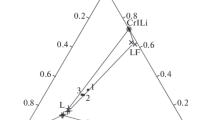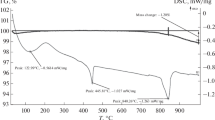Abstract—
The paper reports original thermochemical data obtained on natural oxo-amphibole kaersutite Na0.4K0.3(Ca1.6Na0.4)(Mg2.9\({\text{Fe}}_{{0.8}}^{{2 + }}\)Al0.7Ti0.6\({\text{Fe}}_{{0.5}}^{{3 + }}\))[Si6.1Al1.9O22](OH)0.2O1.8 from alkaline basalt in Mongolia. The data were obtained using a Tian–Calvet microcalorimeter. The enthalpy of formation from elements Δf\(H_{{{\text{el}}}}^{{\text{0}}}\)(298.15 K) = –12102 ± 16 kJ/mol) was obtained by high-temperature melt solution calorimetry. The entropy, enthalpy, and Gibbs energy of formation of the end members of the isomorphic series kaersutite NaCa2Mg3TiAl[Si6Al2O22]O2–ferrikaersutite NaCa2Mg3TiFe3+[Si6Al2O22]O2 were estimated.



Similar content being viewed by others
REFERENCES
S. Ando E. Garzanti, “Raman spectroscopy in heavy-mineral studies,” Sediment Provenance Studies in Hydrocarbon Exploration and Production, Ed. by R. A. Scott, H. R. Smyth, A. C. Morton, and N. Richardson, Geol. Soc. London, Spec. Publ. 386, 395–412 (2014).
A. I. Apopei, N. Buzgar, and A. Buzatu, “Raman and infrared spectroscopy of kaersutite and certain common amphiboles,” An. Stiint. U. Al. I. Geol. 57 (2), 35–58 (2011).
O. A. Bogatikov and E. D. Andreeva, “On kaersutite from gabbro of Mt. Patyn (Kuznetsk Alatau),” Minerals from Mafic Rocks in Relation to Petrogenesis (Nauka. Moscow, 1970), pp. 64–60 [in Russian].
N. V. Chukanov, Infrared Spectra of Mineral Species: Extended Library (Springer-Verlag GmbH, Dordrecht–Heidelberg–New York–London, 2014).
A. A. Colville and G. A. Novak, “Kaersutite megacrysts and associated crystal inclusion from the Cima volcanic fields, San Bernardino County, California,” Lithos 27, 107–114 (1991).
N. O. Gopal, K. V. Narasimhulu, and J. L. Rao, “EPR, optical, infrared and Raman spectral studies of actinolite mineral,” Spectrochim. Acta A 60, 2441–2448 (2004).
F. C. Hawthorne and H. D. Grundy, “The crystal chemistry of the amphiboles. II. Refinement of the crystal structure of oxy-kaersutite,” Mineral. Mag. 39, 390–400 (1973).
F. C. Hawthorne, R. Oberti, G. E. Harlow, W. V. Maresch, R. F. Martin, J. C. Schumacher, M. D. Welch, “Nomenclature of the amphibole supergroup,” Am. Mineral. 97, 2031–2048 (2012).
T. J. B. Holland, “Dependence of entropy on volume for silicate and oxide minerals: a review and a predictive model,” Am. Mineral. 74, 5–13 (1989).
K. Ishida, D. M. Jenkins, and F. C. Hawthorne, “Mid-IR bands of synthetic calcic amphiboles of tremolite–pargasite series and of natural calcic amphiboles,” Am. Mineral. 93 (7), 5–13 (2008).
V. K. Karzhavin, “Amphiboles: thermodynamic properties,” Geokhimiya, No. 12, 1724–1731 (1991).
I. A. Kiseleva, “Thermodynamic properties and stability of pyrope,” Geokhimiya, No. 6, 845–854 (1976).
I. A. Kiseleva, and L. P. Ogorodova, Application of high-temperature solution calorimetry for determination of the enthalpies of formation of hydroxyl-bearing minerals with reference to talc and tremolite,” Geokhimiya, no. 12, 1745–1755 (1983).
I. A. Kiseleva, L. P. Ogorodova, N. D. Topor, and O. G. Chigareva, “Thermochemical study of the CaO–MgO–SiO2 system,” Geokhimiya, No. 12, 1811–1825 (1979).
I. A. Kiseleva, A. Navrotsky, I. A. Belitsky, and B. A. Fursenko, “Thermochemical study of calcium zeolites–heulandite and stilbite,” Am. Mineral. 86, 448–455 (2001).
P. Makreski, G. Jovanovski, and A. Gajović, “Minerals from Macedonia XVII. Vibrational spectra of some common appearing amphiboles,” Vib. Spectrosc. 40, 98–109 (2006).
F. M. McCubbin, A. Smirnov, H. Nekvasil, J.Wang, E. Hauri, and D. H. Lindsley, “Hydrous magmatism on Mars: a source of water for the surface and subsurface during the Amazonian,” Earth Planet. Sci. Lett. 292, 132–138 (2010).
T. Mikouchi and M. Miyamoto, “Micro Raman spectroscopy of amphiboles and pyroxenes in the martian meteorites Zagami and Lewis Cliff 88516,” Meteorit. Planet. Sci. 35, 155–159 (2000).
M. E. Minitti, L. A. Leshin, M. D. Dyar, T. J. Ahrens, Y.Guan, and S.-N. Luo, “Assessment of shock effects on amphibole water contents and hydrogen isotope compositions: 2. Kaersutitic amphibole experiments,” Earth Planet. Sci. Lett. 266, 288–302 (2008).
A. Navrotsky and W. J. Coons, “Thermochemistry of some pyroxenes and related compounds,” Geochim. Cosmochim. Acta 40, 1281–1295 (1976).
L. P. Ogorodova, L. V. Melchakova, I. A. Kiseleva, and I. A. Belitsky, “Thermochemical study of natural pollucite,” Thermochim. Acta 403, 251–256 (2003).
L. P. Ogorodova, I. A. Kiseleva, M. F. Vigasina, L. V. Melchakova, I. A. Bryzgalov, and D. A. Ksenofontov, “Thermodynamic study of calcic amphiboles,” Geochem. Int. 55 (9), 814–821 (2017a).
L. P. Ogorodova, I. A. Kiseleva, M. F. Vigasina, L. V. Mel’chakova, D. A. Ksenofontov, and I. A. Bryzgalov, “Thermochemical study Mg–Fe amphiboles,” Geochem. Int. 55 (7), 669–673 (2017b).
L. P. Ogorodova, I. A. Kiseleva, M. F. Vigasina, Yu. D. Gritsenko, I. A. Bryzgalov, and L. V. Melchakova, “Thermochemical study of sodic and sodic–calcic amphiboles,” Geokhimiya (in press).
A. S. Osokin, “Kaersutite from contact-metasomatic rocks of the Kurga massif, Kola Peninsula,” Mineralogy and Geochemistry (LGU, Leningrad, 1968), vol. 3, pp. 21–26.
R. A. Robie and B. S. Hemingway, “Thermodynamic properties of minerals and related substances at 298.15 K and 1 bar (105 Pascals) pressure and at higher temperatures,” U.S. Geol. Surv. Bull. 2131, (1995)
R. A. Robie and J. W. Stout, “Heat capacity from 12 to 305 K and entropy of talc and tremolite,” J. Phys. Chem. 67, 2252–2256 (1963).
V. V. Severov, L. O. Filippov, and I. V. Filippova, “Relationship between cation distribution with electrochemical and flotation properties of calcic amphiboles,” Int. J. Miner. Process. 147, 18–27 (2016).
E. L. Walton, T. G. Sharp, and J. Hu, “Frictional melting processes and the generation of shock veins in terrestrial structures: Evidence from the Steen River impact structure, Alberta, Canada,” Geochim. Cosmochim. Acta 180, 256–270 (2016).
ACKNOWLEDGMENTS
The authors thank Prof. E.M. Spiridonov, Geological Faculty, Lomonosov Moscow State University) for providing a kaersutite sample for this study.
Author information
Authors and Affiliations
Corresponding author
Additional information
Translated by E. Kurdyukov
Rights and permissions
About this article
Cite this article
Ogorodova, L.P., Gritsenko, Y.D., Vigasina, M.F. et al. Natural Kaersutite: FTIR, Raman, Thermal, and Thermochemical Studies. Geochem. Int. 57, 716–721 (2019). https://doi.org/10.1134/S0016702919060089
Received:
Revised:
Accepted:
Published:
Issue Date:
DOI: https://doi.org/10.1134/S0016702919060089




